
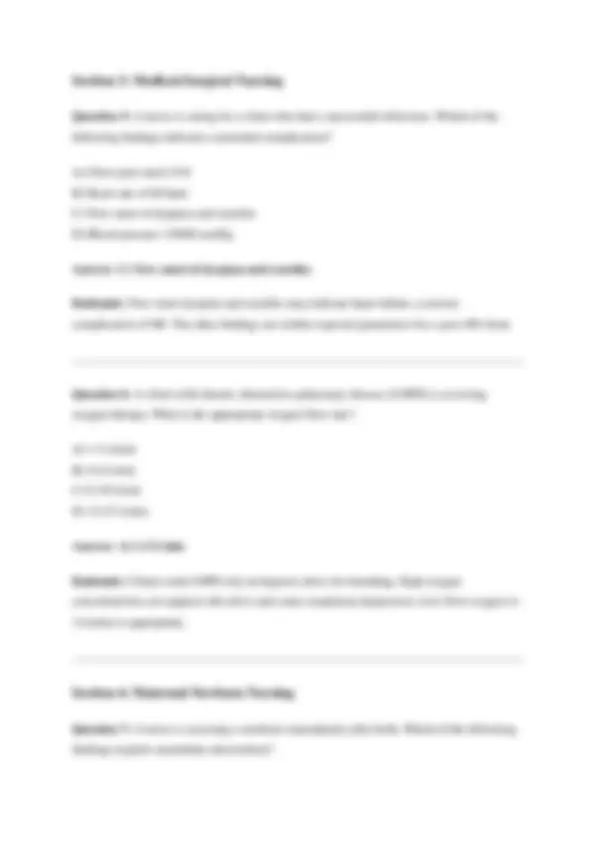
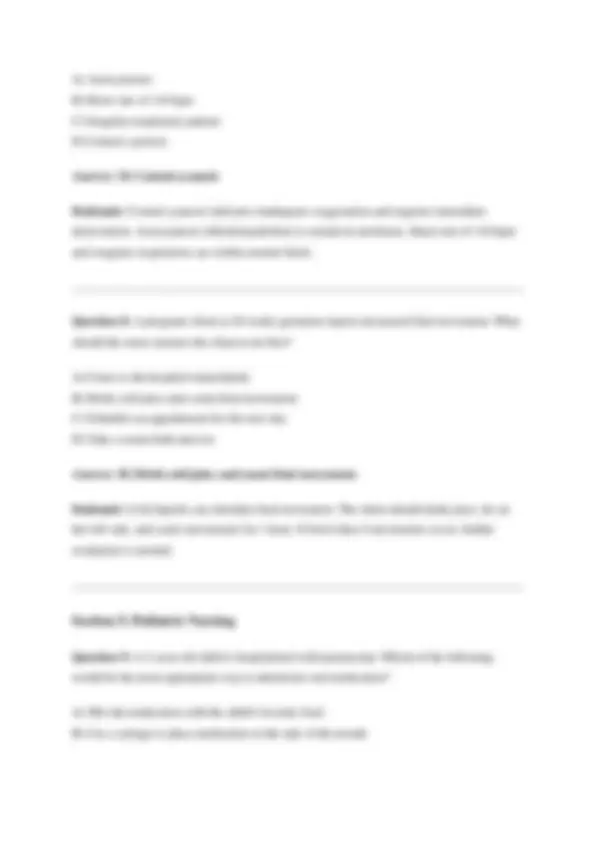
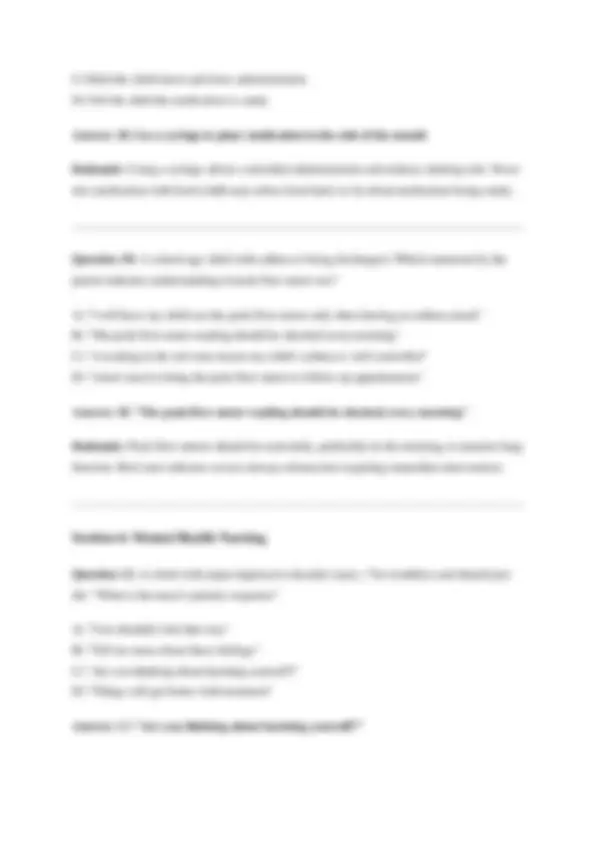
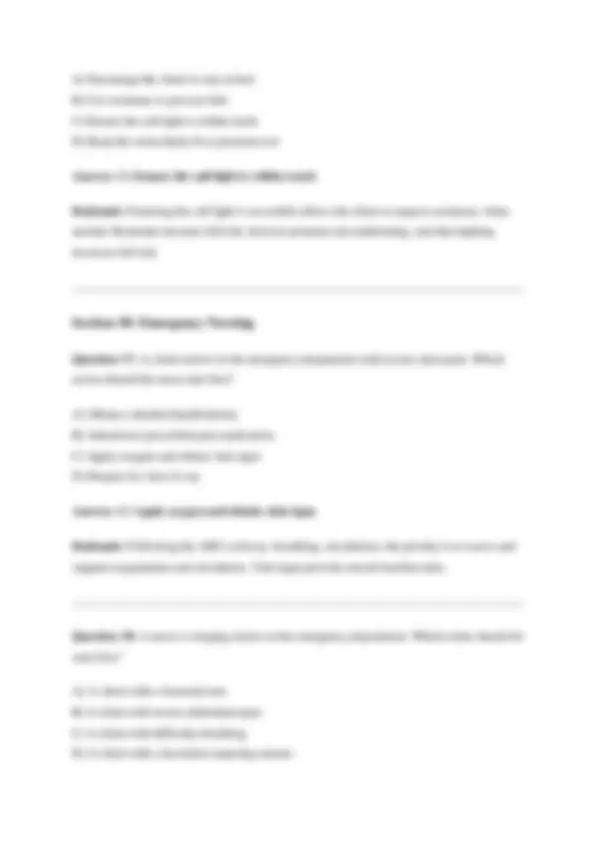
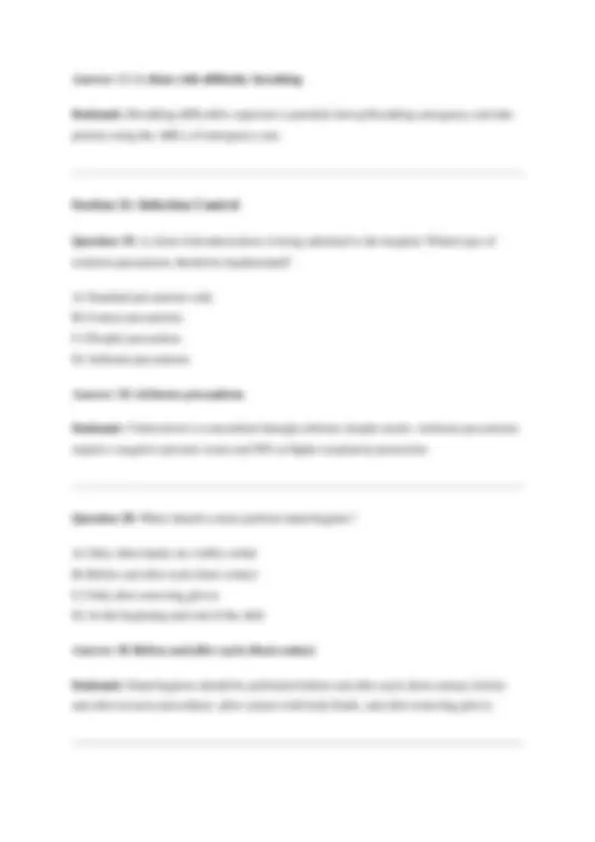
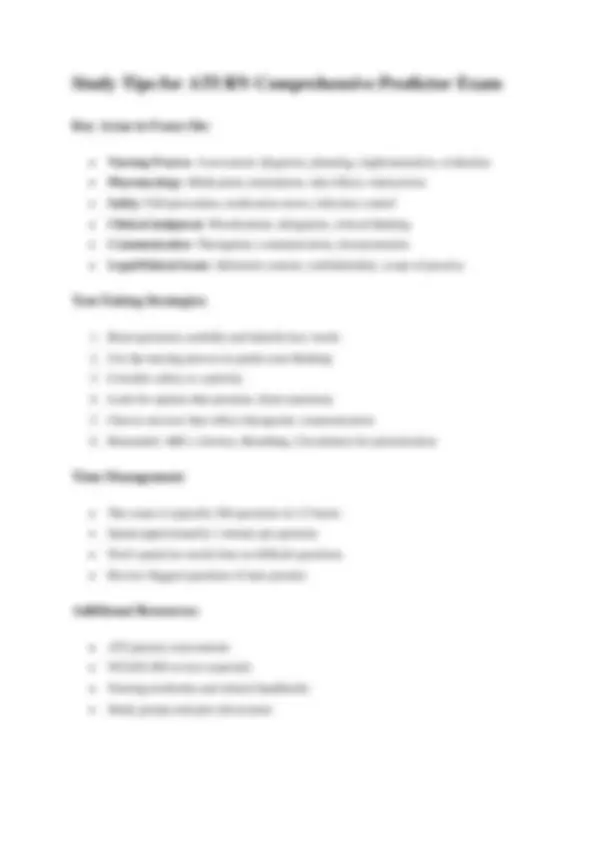


Study with the several resources on Docsity

Earn points by helping other students or get them with a premium plan


Prepare for your exams
Study with the several resources on Docsity

Earn points to download
Earn points by helping other students or get them with a premium plan
Community
Ask the community for help and clear up your study doubts
Discover the best universities in your country according to Docsity users
Free resources
Download our free guides on studying techniques, anxiety management strategies, and thesis advice from Docsity tutors
ATI RN Comprehensive Predictor Exam 2025/2026 - Complete Study Guide Course: RN Comprehensive Predictor Preparation Year: 2025/2026 Academic Year Subject: Nursing (RN Program) Content: verified practice questions with detailed rationales Index Coverage: Fundamentals & Pharmacology Med-Surg & Emergency Nursing Maternal-Newborn & Pediatrics Mental Health & Gerontology Leadership & Infection Control Community Health Nursing Features: ✅ Evidence-based answers with clinical rationales ✅ NCLEX-style questions matching ATI format ✅ Test-taking strategies & time management tips ✅ Safety-focused prioritization guidance ✅ Current 2025 nursing standards Target: Nursing students preparing for ATI Comprehensive Predictor Exam, final semester review, NCLEX-RN preparation Format: Structured Q&A with comprehensive explanations, study tips, and exam strategies. Essential for RN program completion and boards preparation. Perfect for final semester nursing students and NCLEX review.
Typology: Exams
1 / 10

This page cannot be seen from the preview
Don't miss anything!







Question 1: A nurse is caring for a client who has a pressure ulcer on the coccyx. Which of the following interventions should the nurse implement to promote healing? A) Keep the wound bed moist and covered B) Apply hydrogen peroxide to clean the wound C) Massage the area around the wound D) Position the client directly on the wound Answer: A) Keep the wound bed moist and covered Rationale: Moist wound healing promotes cell migration and tissue repair. Hydrogen peroxide can damage healthy tissue, massaging can cause further tissue damage, and positioning on the wound increases pressure. Question 2: A nurse is preparing to administer medications to a client. Which of the following represents the correct application of the "Five Rights" of medication administration? A) Right client, right medication, right dose, right route, right documentation B) Right client, right medication, right dose, right route, right time C) Right client, right medication, right dose, right frequency, right time D) Right client, right medication, right indication, right route, right time Answer: B) Right client, right medication, right dose, right route, right time
Rationale: The traditional "Five Rights" include: right client, right medication, right dose, right route, and right time. Documentation is important but not part of the original five rights.
Question 3: A nurse is caring for a client who is receiving warfarin therapy. Which laboratory value should the nurse monitor? A) Activated partial thromboplastin time (aPTT) B) International normalized ratio (INR) C) Platelet count D) Hemoglobin level Answer: B) International normalized ratio (INR) Rationale: INR is used to monitor warfarin therapy effectiveness. The therapeutic range is typically 2.0-3.0 for most conditions. aPTT is used to monitor heparin therapy. Question 4: A client is prescribed digoxin 0.25 mg daily. Before administering the medication, the nurse should assess which of the following? A) Blood pressure B) Respiratory rate C) Apical pulse D) Temperature Answer: C) Apical pulse Rationale: Digoxin affects heart rate and rhythm. The nurse should check the apical pulse for 1 full minute before administration. Hold the medication if the pulse is below 60 bpm in adults.
A) Acrocyanosis B) Heart rate of 110 bpm C) Irregular respiratory pattern D) Central cyanosis Answer: D) Central cyanosis Rationale: Central cyanosis indicates inadequate oxygenation and requires immediate intervention. Acrocyanosis (bluish hands/feet) is normal in newborns. Heart rate of 110 bpm and irregular respirations are within normal limits. Question 8: A pregnant client at 28 weeks gestation reports decreased fetal movement. What should the nurse instruct the client to do first? A) Come to the hospital immediately B) Drink cold juice and count fetal movements C) Schedule an appointment for the next day D) Take a warm bath and rest Answer: B) Drink cold juice and count fetal movements Rationale: Cold liquids can stimulate fetal movement. The client should drink juice, lie on her left side, and count movements for 1 hour. If fewer than 4 movements occur, further evaluation is needed.
Question 9: A 2-year-old child is hospitalized with pneumonia. Which of the following would be the most appropriate way to administer oral medication? A) Mix the medication with the child's favorite food B) Use a syringe to place medication in the side of the mouth
C) Hold the child down and force administration D) Tell the child the medication is candy Answer: B) Use a syringe to place medication in the side of the mouth Rationale: Using a syringe allows controlled administration and reduces choking risk. Never mix medication with food (child may refuse food later) or lie about medication being candy. Question 10: A school-age child with asthma is being discharged. Which statement by the parent indicates understanding of peak flow meter use? A) "I will have my child use the peak flow meter only when having an asthma attack" B) "The peak flow meter reading should be checked every morning" C) "A reading in the red zone means my child's asthma is well controlled" D) "I don't need to bring the peak flow meter to follow-up appointments" Answer: B) "The peak flow meter reading should be checked every morning" Rationale: Peak flow meters should be used daily, preferably in the morning, to monitor lung function. Red zone indicates severe airways obstruction requiring immediate intervention.
Question 11: A client with major depressive disorder states, "I'm worthless and should just die." What is the nurse's priority response? A) "You shouldn't feel that way" B) "Tell me more about these feelings" C) "Are you thinking about harming yourself?" D) "Things will get better with treatment" Answer: C) "Are you thinking about harming yourself?"
Question 14: A nurse discovers that a medication error has occurred. What should be the nurse's first action? A) Complete an incident report B) Notify the provider C) Assess the client D) Document the error in the medical record Answer: C) Assess the client Rationale: Client safety is the priority. The nurse should first assess the client for any adverse effects from the error, then notify the provider, complete documentation, and file an incident report.
Question 15: A public health nurse is conducting a health screening at a community center. Which of the following represents primary prevention? A) Mammography screening for breast cancer B) Blood pressure checks for hypertension C) Influenza vaccination D) Glucose monitoring for diabetes Answer: C) Influenza vaccination Rationale: Primary prevention prevents disease occurrence. Vaccination prevents influenza. The other options are secondary prevention (early detection of disease).
Question 16: An elderly client is at risk for falls. Which intervention should the nurse implement?
A) Encourage the client to stay in bed B) Use restraints to prevent falls C) Ensure the call light is within reach D) Keep the room dimly lit to promote rest Answer: C) Ensure the call light is within reach Rationale: Ensuring the call light is accessible allows the client to request assistance when needed. Restraints increase fall risk, bed rest promotes deconditioning, and dim lighting increases fall risk.
Question 17: A client arrives in the emergency department with severe chest pain. Which action should the nurse take first? A) Obtain a detailed health history B) Administer prescribed pain medication C) Apply oxygen and obtain vital signs D) Prepare for chest X-ray Answer: C) Apply oxygen and obtain vital signs Rationale: Following the ABCs (airway, breathing, circulation), the priority is to assess and support oxygenation and circulation. Vital signs provide crucial baseline data. Question 18: A nurse is triaging clients in the emergency department. Which client should be seen first? A) A client with a fractured arm B) A client with severe abdominal pain C) A client with difficulty breathing D) A client with a laceration requiring sutures
Study Tips for ATI RN Comprehensive Predictor Exam
Nursing Process : Assessment, diagnosis, planning, implementation, evaluation Pharmacology : Medication calculations, side effects, interactions Safety : Fall prevention, medication errors, infection control Clinical Judgment : Prioritization, delegation, critical thinking Communication : Therapeutic communication, documentation Legal/Ethical Issues : Informed consent, confidentiality, scope of practice
The exam is typically 180 questions in 3.5 hours Spend approximately 1 minute per question Don't spend too much time on difficult questions Review flagged questions if time permits
ATI practice assessments NCLEX-RN review materials Nursing textbooks and clinical handbooks Study groups and peer discussions